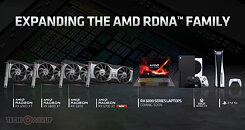
Oddball Radeon RX 6500 (non-XT) Surfaces in the Chinese Market
AMD's entry-level graphics lineup sees the Radeon RX 6400 at the very bottom, followed by the RX 6500 XT, which is for all intents and purposes, an entry-level discrete GPU, given that its performance is in league of processor integrated graphics (iGPUs). It turns out that AMD had planned a SKU between the two, the RX 6500 (non-XT), and this chip is beginning to surface on entry-level graphics cards in China. A less-known AIB named Zephyr is selling an interesting single-slot low-profile card with dimensions resembling some RX 6400 cards. There's also a more fleshed out full-height, dual-slot card.
The RX 6500 appears to have the same core-configuration as the RX 6500 XT, both SKUs max out the "Navi 24" silicon they're based on. These chips are powered by the two generations older RDNA 2 graphics architecture, AMD's first to meet DirectX 12 Ultimate logo requirements. The RX 6500 is configured with all 16 CU present on the silicon, giving it 1,024 stream processors, and 16 RT accelerators, besides 64 TMUs and 32 ROPs and 16 MB of Infinity Cache. The chip gets 4 GB of GDDR6 memory across the 64-bit wide memory bus of the silicon.
The RX 6500 appears to have the same core-configuration as the RX 6500 XT, both SKUs max out the "Navi 24" silicon they're based on. These chips are powered by the two generations older RDNA 2 graphics architecture, AMD's first to meet DirectX 12 Ultimate logo requirements. The RX 6500 is configured with all 16 CU present on the silicon, giving it 1,024 stream processors, and 16 RT accelerators, besides 64 TMUs and 32 ROPs and 16 MB of Infinity Cache. The chip gets 4 GB of GDDR6 memory across the 64-bit wide memory bus of the silicon.




































